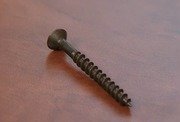Blowing In Cellulose Insulation
Bob joins Joe Sheridan (from Energy Guard) to learn more about the US Greenfiber Cocoon cellulose insulation being used in the barn.
Clip Summary
Bob joins Joe Sheridan (from Energy Guard) to learn more about the US Greenfiber Cocoon cellulose insulation application taking place in the barn. First, a mesh material is attached behind the wall cavities in order to hold the cellulose in place until the drywall is applied. The cellulose is ground-up newspaper treated during the manufacturing process with borates (to resist fungus growth).The material is mixed with moisture and blown into the stud cavities. Any that falls onto the ground is vacuumed up and sucked back to the truck where it is remixed and blown back out again.
While one installer blows the insulation in, a second man follows with a stud scrubber, leveling the cellulose. The goal is to create a tight fit, eliminating air movement through the wall.
Upstairs in the attic, the Energy Guard crew is doing a dry application. The cellulose is blown in under pressure. The hose is fed down to the bottom of the cavity and pulled back as the cavity fills up. A proper vent in the ceiling is not necessary, because the insulation is so dense that air doesn't travel through the insulation, and moisture never gets out to the roof sheathing.





